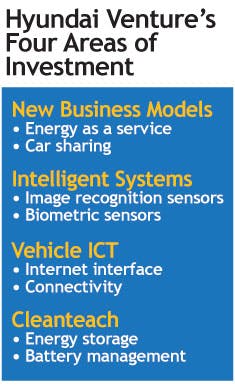Expansion Management: Why the Auto Industry Is Driving to Silicon Valley
If you want to be at the top of your game, you had better make sure you are playing on the right field. That's how Hyundai Ventures views its entrance into Silicon Valley.
"Silicon Valley was where to go if you wanted to grow," explains John W. Suh, director of Hyundai Ventures. "We had a deep corporate venture network in Korea; we needed to expand to the U.S."
The group, which is the auto company's strategic investment and partnership arm in Silicon Valley, opened the office in 2011. Its mission is to back companies that possess technologies, products or capabilities in key areas.
See Also: Manufacturing Plant Site Location Strategies
Suh's job is to make sure he can dissect and communicate what the emerging technologies are and let the corporate office know how these technologies will translate into competitive advantages.
To do this Hyundai Ventures focuses on four areas: the convergence of mobile device, digital media, and wireless communication; clean-tech for automotive applications; intelligent systems and new business models in personal mobility; automotive product development and supply chain.
The necessity of being at the heart of innovation where disruptive technologies are being created is not lost on Hyundai. "We do not want our fate to be the same as a few very large manufacturers who lost sight of how quickly technology changes and are no longer leaders in businesses they created," says Suh.
Hyundai is not alone in this thinking. Silicon Valley is now home to every major automotive company in the world. "Silicon Valley has its own technology-based ecosystem in which the mobile infrastructure companies are overlapping with the auto sector," said Mark Zawacki, CEO of 650 Labs, which advises manufacturing companies on how to leverage Silicon Valley's offerings. Last year Nissan opened an R&D center, as did Mercedes and Ford. BMW and Honda opened their research facilities within the past two years.
And it's not just auto companies that are making sure they have a finger on the pulse of technology breakthroughs. "Over 200 non-tech multinationals in a myriad of sectors are now building strategic beachheads in Silicon Valley to stay close to industry disruption," says Zawacki.
| To learn about other hot spots of innovation around the country, go to www.industryweek.com/expansion-management |
What is it about the area that fosters such a high level of innovation? "In Silicon Valley there is a constant mixing of ideas, from a variety of sources," says Suh. "One example is the Autotech Council. Even though we are competitors, all of the auto companies meet to discuss how we can take the emerging technology and bring it into our companies."
Not only are the ideas brewing, but the area has reached a critical mass of "serial acquirers, serial disruptors and clusters of industry verticals forming that continue to shape the future of many industries, " explains Zawacki.
"Don't think of Silicon Valley as just 'high tech stuff' — that's a dated (and dangerous) notion. Study how it combines technology and business model innovation, then accesses that layer of information in your industry."

